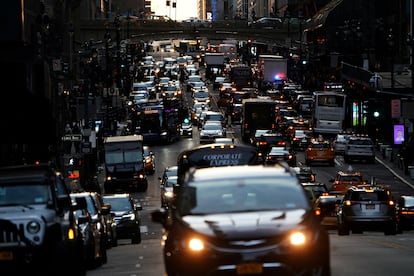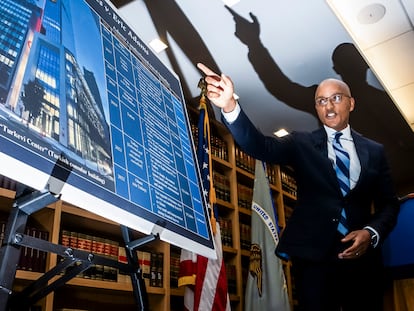New York speeds up plan to charge $9 toll for driving into central Manhattan over Trump fears
The state hopes to get the green light from the federal government before the transition of power. If approved, it will be the first urban traffic restriction in the US, mirroring those in many European capitals


Car restrictions in city centers, so common in Europe, seem anathema in the United States, which is much more dependent on private vehicles. New York, arguably the most European of America’s cities, has been trying for more than a year to impose a congestion pricing plan to access Manhattan‘s Central Business District — similar to those already in place in London, Milan or Stockholm. Although the project has taken several tumbles since its initial conception, fear of the announced cut in public spending by the incoming Trump administration has reactivated the toll plan. If the outgoing Biden administration gives final approval, drivers will have to pay $9 to access the area starting January 5. In London, drivers are already paying a £15 ($18) daily fee for driving in the Congestion Charge zone.
The revised congestion pricing plan, with a new base toll of $9 (down from the original proposed $15), was approved this week by the Metropolitan Transportation Authority (MTA) in the hope of obtaining the final authorization from the outgoing Democratic administration before the transfer of power on January 20. The aim of the plan, adopted by 12 votes to 1, is also to raise money to cover the maintenance of heavily used infrastructure, such as the bypass between New Jersey and Manhattan, and facilities that are in desperate need of renovation, such as those on the subway. The plan now needs to go through a federal review process.
In light of the overwhelming Trump victory on Election Day, the MTA board held a hastily rescheduled meeting on Monday and approved the new daytime fee to enter below 60th Street, the southern limit of Central Park. The board also agreed to update prices in 2028 and 2031, until it reaches the initial proposed amount of $15.
The process was completed in record time after New York Governor Kathy Hochul, a Democrat, ended the pause that had paralyzed the initiative in June, a month after it was approved, due to the high cost of the fares, which was proving very unpopular politically on the eve of the presidential elections (and the local elections next year). The question is whether the lower tolls will be able to generate the $15 billion needed for the reforms of the public transit system, something that its promoters see as feasible. According to Hochul, who assures that she did not rush to kickstart the process again due to the Republican victory, the reduced tolls will save drivers about $1,500 a year, and there will be discounts for those who earn less than $50,000 a year but because of their job are forced to enter the zone every day. If it receives Washington’s approval, it will be applied in a city where residents spend an average of 236 hours a year stuck in traffic.
Less than a week after the governor lifted her objections, the plan’s future now rests with the Federal Highway Administration, which must give the final go-ahead because many of Manhattan’s streets, and especially most of its accesses, receive federal funding, such as the aid approved by the Biden administration to renovate the Lincoln Tunnel, which connects Manhattan to New Jersey.
Therein lies the first hurdle. After state lawmakers initially approved congestion pricing in 2019, during Trump’s first term, federal officials declined to provide guidance on what kind of environmental review should be done. The feds eventually gave the go-ahead two months after President Joe Biden was inaugurated in 2021, but the process dragged on with hundreds of environmental impact considerations. The final plan was approved in June 2023, well after New York officials had anticipated.
The president-elect wants to kill the project
“We’re gonna pursue the bureaucratic process with the feds, which we have to go through now because there’s a tweak to the original tolling structure, and then we’re gonna get it going on the fifth of January,” explained an optimistic Janno Lieber, head of the MTA. If it is achieved, it will be the result of a race against the clock and almost against the political enemy by the outgoing federal administration and that of the State of New York, both Democratic.
Trump threatened on social media in May to “kill” congestion pricing during his first week in the White House. Hence the urgency of the MTA to get the toll plan, which would depend on a long-term federal program and, therefore, theoretically be protected, approved before the transition. Five Republican congressmembers from New York, representing residential areas — whose residents are highly dependent on cars — have also threatened to try to overturn the initiative through federal legislation. There are nine pending appeals, mainly from New Jersey — where many New Yorkers live, driven out of the Big Apple by the high cost of housing — and two more from individuals opposed to Hochul’s halting of the plan at the time.
With the introduction of tolls, the deficit-ridden MTA, which has not yet recovered the volume of passengers it had before the Covid pandemic, hopes to be able to carry out a series of improvements. These include the modernization of signals, the extension of the Second Avenue subway to East Harlem, and projects to make more than 20 subway stations accessible for people with disabilities.
Sign up for our weekly newsletter to get more English-language news coverage from EL PAÍS USA Edition
Tu suscripción se está usando en otro dispositivo
¿Quieres añadir otro usuario a tu suscripción?
Si continúas leyendo en este dispositivo, no se podrá leer en el otro.
FlechaTu suscripción se está usando en otro dispositivo y solo puedes acceder a EL PAÍS desde un dispositivo a la vez.
Si quieres compartir tu cuenta, cambia tu suscripción a la modalidad Premium, así podrás añadir otro usuario. Cada uno accederá con su propia cuenta de email, lo que os permitirá personalizar vuestra experiencia en EL PAÍS.
¿Tienes una suscripción de empresa? Accede aquí para contratar más cuentas.
En el caso de no saber quién está usando tu cuenta, te recomendamos cambiar tu contraseña aquí.
Si decides continuar compartiendo tu cuenta, este mensaje se mostrará en tu dispositivo y en el de la otra persona que está usando tu cuenta de forma indefinida, afectando a tu experiencia de lectura. Puedes consultar aquí los términos y condiciones de la suscripción digital.
More information
Archived In
Últimas noticias
Maduro pleads not guilty before the federal court in New York: ‘I am still the president of Venezuela’
A new test can detect Alzheimer’s from a finger prick
UN team enters Sudanese city of El Fasher after paramilitary massacre: ‘It’s like a ghost town’
A recipe for resistance: Indigenous peoples politicize their struggles from the kitchen
Most viewed
- Gilles Lipovetsky: ‘If you want to live better and fall in love, take Prozac, don’t look to philosophy’
- Alain Aspect, Nobel laureate in physics: ‘Einstein was so smart that he would have had to recognize quantum entanglement’
- Alvin Hellerstein, a 92-year-old judge appointed by Bill Clinton, to preside over Maduro’s trial in New York
- Why oil has been at the center of Venezuela-US conflicts for decades
- Maduro’s downfall puts China’s relationship with Venezuela to the test










































